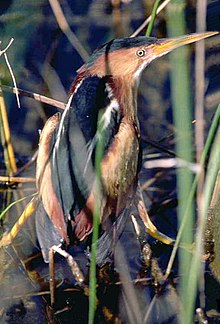Miniature bummies
| Miniature bummies | ||||||||||
|---|---|---|---|---|---|---|---|---|---|---|

Little bittern ( Ixobrychus minutus ) |
||||||||||
| Systematics | ||||||||||
|
||||||||||
| Scientific name | ||||||||||
| Ixobrychus | ||||||||||
| Billberg , 1828 |


The miniature bittern ( Ixobrychus ) are a genus within the heron family, which are counted among the tommers . The genus includes eight recent species that are distributed almost worldwide. A ninth species, the black-backed little bittern ( Ixobrychus novaezelandiae ), became extinct before 1900. In Central Europe the genus is represented by the little bittern.
Appearance
All eight species are relatively small and have 10 tail feathers. The African gray-backed bittern , for example, only reaches a height of 27 to 30 centimeters and weighs 142 grams, while the American bittern , which occurs in both Americas , is up to 36 centimeters tall, but weighs less than 100 grams. The little bittern, which occurs in Central Europe, is between 25 and 35 centimeters tall and weighs 140 to 150 grams.
All species have a compact shape with a relatively short, thick neck for herons. The beak is relatively short and horn-colored or strong yellowish to yellowish-green. Only in the gray-backed bobbin is the beak blackish to dark green with a black tip. The gray-backed bittern and the black bittern have the darkest plumage with their slate-colored to black-brown upper surface. In the other species, brown tones dominate. The striped drumstick is the only type in which the upper side of the body also has longitudinal stripes. Common to all species is the light underside of the body. The neck and front chest each have noticeable, darker longitudinal stripes. The von schrenck's bittern has different from the other species only a dark longitudinal stripes on. Sex dimorphism can be observed in all species . Typically the females are slightly smaller and have less contrasting plumage.
distribution and habitat
Little bitterns are found in North and South America, Asia, Africa, Australia, New Zealand and Europe. All species are at least partially migratory birds. This also applies to the African gray-backed bobble, which migrates to the equatorial region during the dry season. In some species, such as the striped bobbin and the gray-backed bobbin, the movements of the movement have not yet been fully explored; some populations of the species are evidently resident birds that remain in their breeding area all year round. The gray-backed bittern, on the other hand, may even be a nomadic species. The little bittern, which breeds in Eurasia and Africa, has a noticeably disjoint distribution area. One subspecies is also found in New Zealand and another in eastern Australia. Asia has most of the species of bittern.
Way of life and existence
Little bitterns are bound to water in their way of life. Preferred habitat are dense belts of vegetation along fresh waters. But they also occur in salt marshes and mangroves. The food spectrum of the little bittern is very broad and includes fish, crustaceans, frogs, tadpoles, insects and small mammals. The species nest solitary or in very loose colonies.
Due to the very shy way of life, the population numbers of the bittern have been researched to varying degrees. However, the IUCN classifies the stocks as safe ( least concern ). The bittern populations in Europe have been declining for a long time and have decreased very sharply, especially in the period 1970 to 1990.
The now extinct black-backed bittern was at times considered a subspecies of the bittern. Their distribution area included New Zealand and the Chatham Islands . Most of the live specimen observations were on the west coast of New Zealand's South Island , where, among other things, an individual was collected at Lake Wakatipu . On the North Island there was a possible observation from the Tauranga region in 1836 . Otherwise, the black-backed bittern is only known from the North Island through subfossil remains from fossil deposits on Lake Poukawa and from the region of Paekākariki. Other bone material was discovered on the Chatham Islands. The extinction of the black-backed little bittern is thought to be due to the stalking by Pacific rats , brown rats , house rats , polecats , ermines , weasels and feral domestic cats . The bone that was found in a clam pile near Paekākariki is an indication that the black-backed little bittern was also hunted by humans. It was already considered rare before 1860 and probably died out in the 1890s. Today there are 13 preserved specimens, one incomplete skeleton and eight subfossil bones in the Museum of New Zealand Te Papa Tongarewa .
Systematics
The following species are included in the genus of the bittern:
- Striped bobble ( Ixobrychus involucris )
- American bittern ( Ixobrychus exilis )
- Little bittern ( Ixobrychus minutus )
- Chinadommel ( Ixobrychus sinensis )
- Mandschurendommel ( Ixobrychus eurhythmus )
- Cinnamon drum ( Ixobrychus cinnamomeus )
- Gray-backed bobble ( Ixobrychus sturmii )
- Black bittern ( Ixobrychus flavicollis )
- † Black-backed little bittern ( Ixobrychus novaezelandiae )
supporting documents
Single receipts
- ↑ BirdLife Factsheet on Ixobrychus novaezelandiae , accessed September 20, 2009
- ↑ Kushlan et al., P. 329
- ↑ Kushlan et al., P. 310
- ↑ Kushlan et al., P. 314
- ↑ Kushlan et al., P. 306
- ↑ Kushlan et al., P. 330
- ↑ [1] BirdLife Factsheet on Ixobrychus , accessed on September 20, 2009
- ↑ Kushlan et al., P. 316
literature
- James A. Kushlan & James A. Hancock: Herons . Oxford University Press, 2005, ISBN 0-19-854981-4